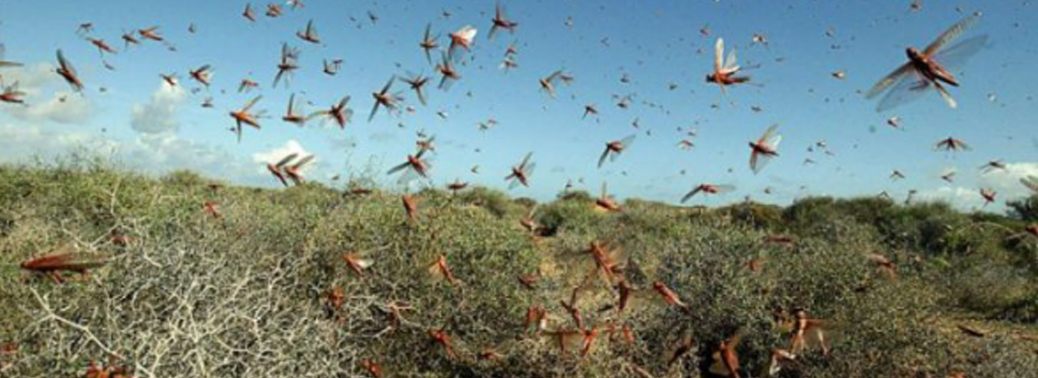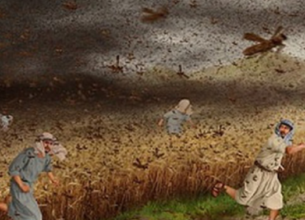LOCUSTS
26, Dec 2019

Prelims level : Environmental Impact Assessment
Mains level : GS-III Conservation, Environmental Pollution and Degradation, Environmental Impact Assessment.
Why in News?
- Recently, Gujarat and Pakistan are under attack by Hopper.
About
- It is known as tiddis locally and have wreaked havoc on standing crops, which includes castor, cumin, jatropha and cotton, and fodder grass.
- The state administration has an alert from the UN Food Agriculture Organisation (FAO) on a massive attack in South Asia.
- The Locust Warning Organisation (LWO) had noticed swarms and predicted their trajectory across the international border.
- The state government along with the central teams has launched huge pesticide-spraying operation to kill the insects. They are currently using a pesticide ‘Malathion’.
- According to LWO, Locust flying in from Pakistan Sindh province and spreading in villages in Rajasthan and Gujarat where south western monsoon had prolonged this time.
- Originally, the locusts emerged from Sudan and Eritrea on Africa’s Red Sea Coast and travelled through Saudi Arabia and Iran to enter Pakistan, where they invaded the Sindh Province and from there they moved into Rajasthan and Gujarat.
- Both the countries are also consistently sharing inputs, including satellite data, via Food and Agricultural Organization (FAO) to counter and restrict the movement of locusts.
Locusts in India:
- It is mainly tropical grasshopper with strong powers of flight. They differ from ordinary grasshoppers in their ability to change behaviour (gregarize) and form swarms that can migrate over large distances.
- It is generally seen during the months of June and July as the insects are active from summer to the rainy season, which spread in approximately over 10 square kilometre area.
- It has a high capacity to multiply, form groups, migrate over relatively long distance up to 150 km per day.
- There are Four species viz. Desert locust(Schistocerca gregaria), Migratory locust (Locusta migratoria), Bombay Locust (Nomadacris succincta) and Tree locust (Anacridium sp.) are found in India.
Threats caused by Locust:
- Locust adults can eat their own weight every day, which is about two grams of fresh vegetation per day.
- Likewise, a very small swarm eats as much in one day as about 35,000 people, posing a devastating threat to crops and food security.
- If not detected and controlled, the devastating plagues can develop that often take several years and hundreds of millions of dollars to bring under control with severe consequences on food security and livelihoods.
Control measures for Locust:
- Destroying egg masses laid by Invading Swarms,
- Digging trenches to trap nymphs,
- Using hopper dozers (wheeled screens that cause locusts to fall into troughs containing water and kerosene),
- Using insecticidal baits, and applying insecticides to both swarms and breeding grounds from Aircraft.
Locust Warning Organization (LWO):
- Locust Warning Organisation (LWO), Directorate of Plant Protection Quarantine and Storage, Ministry of Agriculture & Farmers Welfare, is responsible for monitoring, survey and control of Desert Locust in Scheduled Desert Areas mainly in the States of Rajasthan and Gujarat.
- Incursion of exotic locust swarms into India is prevented through organization of suitable control operation. LWO keeps itself abreast with the prevailing locust situation at National and International level through monthly Desert Locust Bulletins of FAO.
- Its Objectives Include:
- To monitor, forewarn and control locust in Scheduled Desert Area (SDA) being International obligation and commitment.
- To conduct research on locust and grasshoppers.
- Liaison and coordination with National and International Organizations.
- Human resource development through training and demonstration for staff of Locust Warning Organization (LWO), State officials, BSF personnel and Farmers.
- To maintain control potential to combat locust emergency by organizing locust control campaign.
Food and Agricultural Organization:
- It was created In Quebec City, Canada, by the first session of the newly created United Nations.
- It is a specialized agency of the United Nations that leads international efforts to Defeat Hunger.
- It is also a source of knowledge and information, and helps developing countries in transition modernize and improve agriculture, forestry and fisheries practices, ensuring good nutrition and food security for all.








